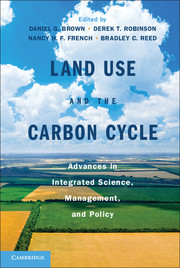Book contents
- Frontmatter
- Contents
- Chapter Authors and Affiliations
- Acknowledgments
- Acronyms
- Part I Introduction
- Part II Measurement and Modeling
- Part III Integrated Science and Research Applications
- Part IV Land Policy, Management, and the Carbon Cycle
- 13 Managing Carbon: Ecological Limits and Constraints
- 14 Effects of Wildland Fire Management on Forest Carbon Stores
- 15 Soil Carbon Dynamics in Agricultural Systems
- 16 U.S. Policies and Greenhouse Gas Mitigation in Agriculture
- 17 Opportunities and Challenges for Offsetting Greenhouse Gas Emissions with Forests
- 18 Opportunities and Challenges for Carbon Management on U.S. Public Lands
- 19 Design and Planning of Residential Landscapes to Manage the Carbon Cycle: Invention and Variation in Land Use and Land Cover
- Part V Synthesis and Future Directions
- Index
- Plate Section
- References
14 - Effects of Wildland Fire Management on Forest Carbon Stores
Published online by Cambridge University Press: 05 February 2013
- Frontmatter
- Contents
- Chapter Authors and Affiliations
- Acknowledgments
- Acronyms
- Part I Introduction
- Part II Measurement and Modeling
- Part III Integrated Science and Research Applications
- Part IV Land Policy, Management, and the Carbon Cycle
- 13 Managing Carbon: Ecological Limits and Constraints
- 14 Effects of Wildland Fire Management on Forest Carbon Stores
- 15 Soil Carbon Dynamics in Agricultural Systems
- 16 U.S. Policies and Greenhouse Gas Mitigation in Agriculture
- 17 Opportunities and Challenges for Offsetting Greenhouse Gas Emissions with Forests
- 18 Opportunities and Challenges for Carbon Management on U.S. Public Lands
- 19 Design and Planning of Residential Landscapes to Manage the Carbon Cycle: Invention and Variation in Land Use and Land Cover
- Part V Synthesis and Future Directions
- Index
- Plate Section
- References
Summary
Introduction
Fire is a natural process that has shaped many terrestrial systems globally (Bowman et al. 2009). The frequency and extent of fire have fluctuated over time as a result of both changes in climate and human land-use patterns (Marlon et al. 2008). Pechony and Shindell (2010) found that prior to the Industrial Revolution, global fire patterns were driven by precipitation. During the Industrial Revolution, a shift toward human-driven fire occurred because of factors such as biomass burning associated with land-use change, and they predict that global fire patterns will be driven primarily by temperature during the twenty-first century. Understanding the feedbacks between human and natural systems and the climate is paramount to understanding fire as a process that both shapes natural systems and contributes to the atmospheric concentration of greenhouse gases (GHGs).
At the end of the twentieth and beginning of the twenty-first century, global fire emissions of carbon (C) ranged from 1.5 to 4 Pg·yr−1, equivalent to approximately half of global fossil fuel emissions (Bowman et al. 2009; Van der Werf et al. 2010). Of these fire-based emissions, grasslands and savannas contributed the greatest proportion (44 percent) and tropical peat fires the smallest (3 percent) (Van der Werf et al. 2010). During this period, forest fires accounted for 15 percent of global fire emissions of C. Although global C emissions from forest fires are relatively small compared with total carbon dioxide (CO2) emissions (38 Pg in 2004), the significance of forest fire emissions is not inconsequential.
- Type
- Chapter
- Information
- Land Use and the Carbon CycleAdvances in Integrated Science, Management, and Policy, pp. 359 - 380Publisher: Cambridge University PressPrint publication year: 2013
References
- 5
- Cited by



